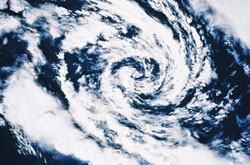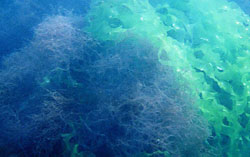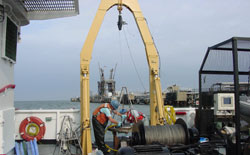You are here: Home › Stressors
Coastal Stressors
Coastal ecosystems change naturally, but external forces, or "stressors," can influence the types and rates of those changes and pose risks to the ecosystems. Naturally occurring stressors and those resulting from human activities can fall into five general categories– pollution, invasive species, extreme events, land and resource uses, and climate change. Any stressor under these five categories can cause ecosystem damage but often they occur in combination and have a cumulative impact. Although we are still learning about the impacts of each stressor individually, it has become increasingly important to tackle the challenge of understanding the combined effects of multiple stressors. CSCOR is at the forefront of NOAA’s effort to address the effects of the stressors that impact our coastal ecosystems using a comprehensive approach.
Climate Change
 Climate
change and climate variability can influence sea level, water temperature
and currents, and stratification (layering) of water bodies. These conditions
influence freshwater delivery, sedimentation, and pollution of an ecosystem.
Salinity, tidal patterns, erosion, and coastal flooding also are affected,
rendering coastal ecosystems and communities
more vulnerable to adverse conditions. With its Climate
Change program, CSCOR has
led the way in NOAA’s
effort to understand how climate change will impact our coastal ecosystems.
More
Climate
change and climate variability can influence sea level, water temperature
and currents, and stratification (layering) of water bodies. These conditions
influence freshwater delivery, sedimentation, and pollution of an ecosystem.
Salinity, tidal patterns, erosion, and coastal flooding also are affected,
rendering coastal ecosystems and communities
more vulnerable to adverse conditions. With its Climate
Change program, CSCOR has
led the way in NOAA’s
effort to understand how climate change will impact our coastal ecosystems.
More
Extreme Natural Events
 Hurricanes, coastal storms, floods, and droughts affect coastal ecosystems and people living along the coasts. Storms can cause major geographic changes in an area and lead to more pollution in coastal ecosystems. The frequency, severity or extent of harmful algal blooms (HABs) can increase after these extreme events, which can lead to costly closures of shellfish beds and can curtail recreational opportunities. Emergency planners and responders benefit from advances in forecasting the effects of these events. They can develop preventive measures that will protect human and ecosystem health. Through its Ecological Forecasting, Harmful Algal Blooms, Impacts of Land Use, and Hypoxia and Nutrient Pollution, CSCOR plays
a leading role in the understanding of the impact of extreme events in the coastal ecosystems and in the development of the forecasting tools necessary to mitigate these impacts. More
Hurricanes, coastal storms, floods, and droughts affect coastal ecosystems and people living along the coasts. Storms can cause major geographic changes in an area and lead to more pollution in coastal ecosystems. The frequency, severity or extent of harmful algal blooms (HABs) can increase after these extreme events, which can lead to costly closures of shellfish beds and can curtail recreational opportunities. Emergency planners and responders benefit from advances in forecasting the effects of these events. They can develop preventive measures that will protect human and ecosystem health. Through its Ecological Forecasting, Harmful Algal Blooms, Impacts of Land Use, and Hypoxia and Nutrient Pollution, CSCOR plays
a leading role in the understanding of the impact of extreme events in the coastal ecosystems and in the development of the forecasting tools necessary to mitigate these impacts. More
Invasive Species
 Nonnative
plants and animals brought to the U.S. from other countries or moved
within U.S. borders to inappropriate habitats can threaten economically and
environmentally important native plants and animals. These nonnative species
often outcompete the native populations for finite ecosystem resources, and
change the general ecological structure, affecting communities with economies
that depend on native species. The Coral
Reefs program at CSCOR has
been instrumental in implementing research efforts to understand the impact
of invasive species in the U.S. coral reef ecosystems. More
Nonnative
plants and animals brought to the U.S. from other countries or moved
within U.S. borders to inappropriate habitats can threaten economically and
environmentally important native plants and animals. These nonnative species
often outcompete the native populations for finite ecosystem resources, and
change the general ecological structure, affecting communities with economies
that depend on native species. The Coral
Reefs program at CSCOR has
been instrumental in implementing research efforts to understand the impact
of invasive species in the U.S. coral reef ecosystems. More
Land and Resource Use
 Uses associated with heavily populated coastlines and development pressures
pose serious risks to the nation's coastal ecosystems.
Urbanization, dredging, and commercial and residential construction can lead
to habitat changes, increased sediment runoff and depleted fish populations.
These activities also can damage habitats that are critical to ensuring ecosystem
vitality. The Climate Change,
Coral Reefs, Ecological Forecasting, Harmful Algal Blooms, Impacts of Land Use, and Hypoxia and Nutrient Pollution programs in CSCOR are
actively engaged in developing and implementing research initiatives that address
the impacts of land and resource use along U.S. coasts. More
Uses associated with heavily populated coastlines and development pressures
pose serious risks to the nation's coastal ecosystems.
Urbanization, dredging, and commercial and residential construction can lead
to habitat changes, increased sediment runoff and depleted fish populations.
These activities also can damage habitats that are critical to ensuring ecosystem
vitality. The Climate Change,
Coral Reefs, Ecological Forecasting, Harmful Algal Blooms, Impacts of Land Use, and Hypoxia and Nutrient Pollution programs in CSCOR are
actively engaged in developing and implementing research initiatives that address
the impacts of land and resource use along U.S. coasts. More
Pollution
 Pollution
directly affects marine ecosystems.
Over the past 30 years, the nation has made great progress in controlling
water pollution from point source discharges, e.g., those with a clearly
identifiable source like an effluent discharge pipe. However, non-point
sources of pollution, such as urban runoff from cities, roads and highways,
and agricultural fields have become more problematic. Air pollution
and excess nitrogen runoff resulting from agricultural operations also
continue to stress fragile marine ecosystems.
Coastal managers need better forecasts on the effects of these different
types of pollution to prioritize management actions. CSCOR, through its Coral Reefs, Ecological Forecasting, Harmful Algal Blooms, and Hypoxia and Nutrient Pollution programs, is developing and sponsoring research to understand the impact of pollution. More
Pollution
directly affects marine ecosystems.
Over the past 30 years, the nation has made great progress in controlling
water pollution from point source discharges, e.g., those with a clearly
identifiable source like an effluent discharge pipe. However, non-point
sources of pollution, such as urban runoff from cities, roads and highways,
and agricultural fields have become more problematic. Air pollution
and excess nitrogen runoff resulting from agricultural operations also
continue to stress fragile marine ecosystems.
Coastal managers need better forecasts on the effects of these different
types of pollution to prioritize management actions. CSCOR, through its Coral Reefs, Ecological Forecasting, Harmful Algal Blooms, and Hypoxia and Nutrient Pollution programs, is developing and sponsoring research to understand the impact of pollution. More

